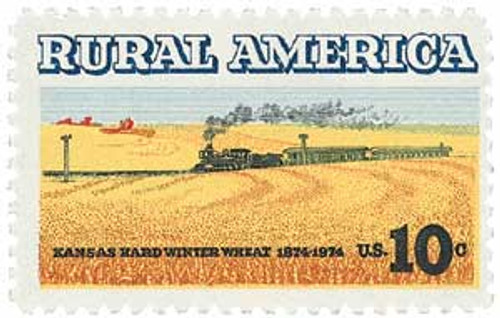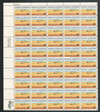
# 1506 - 1974 10c Rural America: Winter Wheat and Train
Rural America
Rural America Series
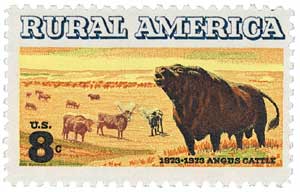
On October 5, 1973, the USPS issued the first of three stamps in the Rural America Series, which honored different aspects of rural life in America.
The first stamp in the series featured an image of an angus bull with Texas longhorns in the background. It was based on a painting by Frank Murphy, a leading agricultural painter.
The stamp was issued in St. Joseph, Missouri, at the headquarters of the American Angus Association. The first day ceremony was held just after the end of the World Angus Forum and marked the first stop on the Centennial National Angus Tour.
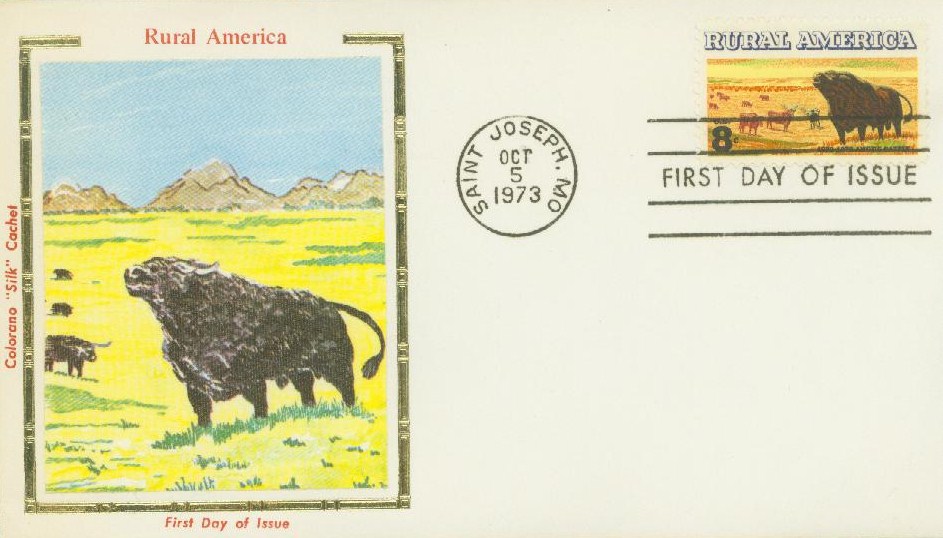
The stamp honored the 100th anniversary of the arrival of Scottish black angus cattle to the United States. Angus cattle are a breed of black, hornless beef cattle that originated in Scotland. George Grant brought four angus bulls from Scotland and transported them to his ranch on the Kansas prairie in 1873. When two of them were exhibited at the Kansas City Livestock Expo, some farmers thought they were “freaks” because of their hornless heads.
Grant crossbred the bulls with native Texas longhorn cows to produce hornless black calves that wintered well on the prairie. Others noticed the quality of Grant’s herd and began their own. Between 1878 and 1883, 1,200 more angus were imported from Scotland.
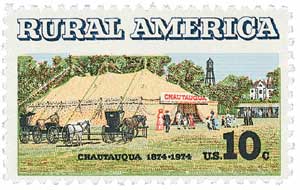
The Rural America Series continued in 1974 with the issue of the Chautauqua Tent Stamp on August 6, 1974, in Chautauqua, New York. In 1874, Reverend John H. Vincent and Lewis Miller of Akron, Ohio, organized a training program for Methodist Sunday-school teachers. This school was held along the shores of Chautauqua Lake, New York, and called the Chautauqua Lake Sunday School Assembly program.
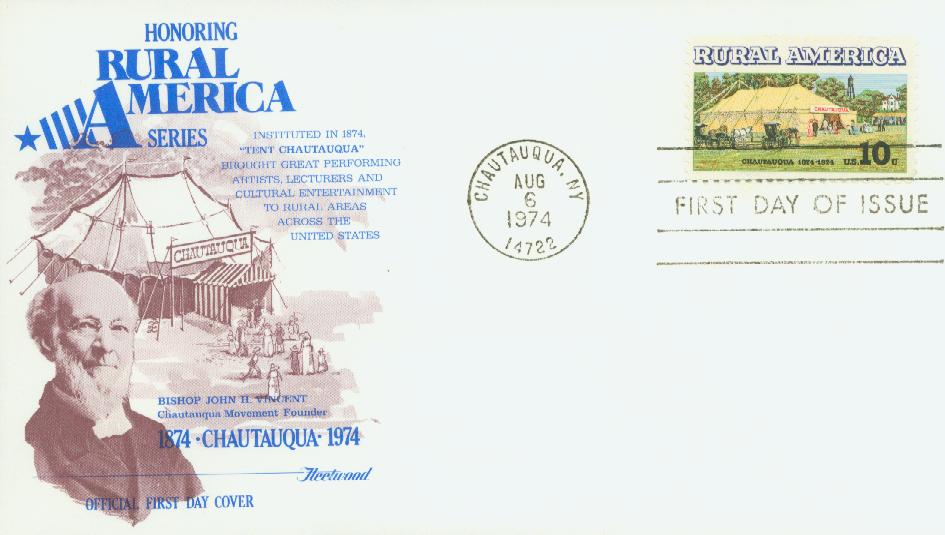
This summer-school program quickly moved from its original religious orientation to include music, art, and secular education and offering credit and non-credit courses for adults. By the early 1900s, “Chautauqua” became a term for commercial traveling companies who pitched tents and presented lecturers, public speakers, and performing artists to rural areas. Tent Chautauquas were popular in rural towns in the early 1900s. They provided cultural entertainment in the form of lectures, concerts, and recitals.
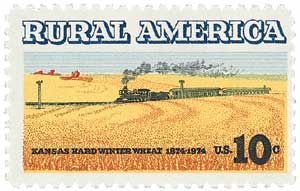
The final stamp in the series was issued 10 days after the second, on August 16, 1974, in Hillsboro, Kansas. It commemorated the 100th anniversary of the introduction of “turkey red” wheat to Kansas. Many consider the introduction of this hardy, drought-resistant grain to be one of the most significant events in Kansas’s history…
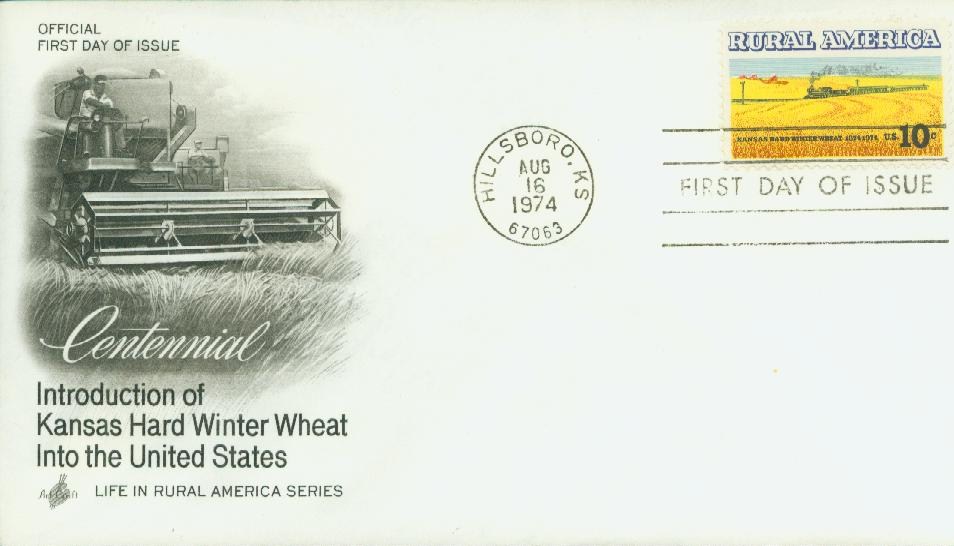
On August 16, 1874, Mennonite immigrants from Russia settled in Marion, Kansas. These settlers planted a wheat they called “turkey red” – drought-resistant, heavy-yielding wheat developed in Turkey. This wheat, now known as hard winter wheat, flourished in Kansas. Turkey red made Kansas one of the world’s greatest granaries.
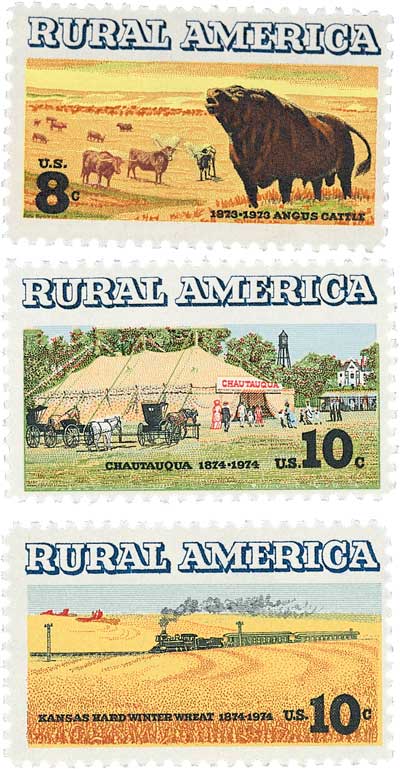
Although manufacturing and services now bring the state more income, agriculture is still very important to the economy. Kansas ranks third in the nation, behind Texas and Montana, in the total number of acres devoted to agriculture. It’s the nation’s top wheat grower, which has earned Kansas the nickname – the “nation’s breadbasket.”
Rural America
Rural America Series

On October 5, 1973, the USPS issued the first of three stamps in the Rural America Series, which honored different aspects of rural life in America.
The first stamp in the series featured an image of an angus bull with Texas longhorns in the background. It was based on a painting by Frank Murphy, a leading agricultural painter.
The stamp was issued in St. Joseph, Missouri, at the headquarters of the American Angus Association. The first day ceremony was held just after the end of the World Angus Forum and marked the first stop on the Centennial National Angus Tour.

The stamp honored the 100th anniversary of the arrival of Scottish black angus cattle to the United States. Angus cattle are a breed of black, hornless beef cattle that originated in Scotland. George Grant brought four angus bulls from Scotland and transported them to his ranch on the Kansas prairie in 1873. When two of them were exhibited at the Kansas City Livestock Expo, some farmers thought they were “freaks” because of their hornless heads.
Grant crossbred the bulls with native Texas longhorn cows to produce hornless black calves that wintered well on the prairie. Others noticed the quality of Grant’s herd and began their own. Between 1878 and 1883, 1,200 more angus were imported from Scotland.

The Rural America Series continued in 1974 with the issue of the Chautauqua Tent Stamp on August 6, 1974, in Chautauqua, New York. In 1874, Reverend John H. Vincent and Lewis Miller of Akron, Ohio, organized a training program for Methodist Sunday-school teachers. This school was held along the shores of Chautauqua Lake, New York, and called the Chautauqua Lake Sunday School Assembly program.

This summer-school program quickly moved from its original religious orientation to include music, art, and secular education and offering credit and non-credit courses for adults. By the early 1900s, “Chautauqua” became a term for commercial traveling companies who pitched tents and presented lecturers, public speakers, and performing artists to rural areas. Tent Chautauquas were popular in rural towns in the early 1900s. They provided cultural entertainment in the form of lectures, concerts, and recitals.

The final stamp in the series was issued 10 days after the second, on August 16, 1974, in Hillsboro, Kansas. It commemorated the 100th anniversary of the introduction of “turkey red” wheat to Kansas. Many consider the introduction of this hardy, drought-resistant grain to be one of the most significant events in Kansas’s history…

On August 16, 1874, Mennonite immigrants from Russia settled in Marion, Kansas. These settlers planted a wheat they called “turkey red” – drought-resistant, heavy-yielding wheat developed in Turkey. This wheat, now known as hard winter wheat, flourished in Kansas. Turkey red made Kansas one of the world’s greatest granaries.

Although manufacturing and services now bring the state more income, agriculture is still very important to the economy. Kansas ranks third in the nation, behind Texas and Montana, in the total number of acres devoted to agriculture. It’s the nation’s top wheat grower, which has earned Kansas the nickname – the “nation’s breadbasket.”

